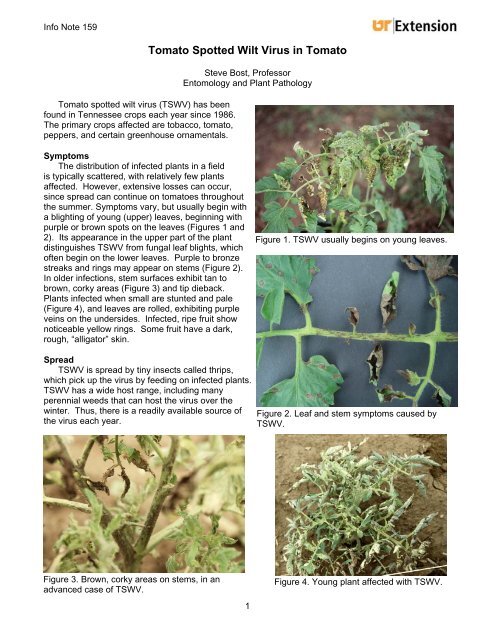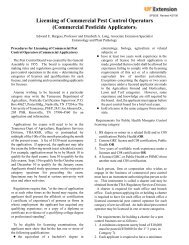Tomato Spotted Wilt Virus in Tomato.pdf
Tomato Spotted Wilt Virus in Tomato.pdf
Tomato Spotted Wilt Virus in Tomato.pdf
Create successful ePaper yourself
Turn your PDF publications into a flip-book with our unique Google optimized e-Paper software.
Info Note 159<strong>Tomato</strong> spotted wilt virus (TSWV) has beenfound <strong>in</strong> Tennessee crops each year s<strong>in</strong>ce 1986.The primary crops affected are tobacco, tomato,peppers, and certa<strong>in</strong> greenhouse ornamentals.<strong>Tomato</strong> <strong>Spotted</strong> <strong>Wilt</strong> <strong>Virus</strong> <strong>in</strong> <strong>Tomato</strong>Steve Bost, ProfessorEntomology and Plant PathologySymptomsThe distribution of <strong>in</strong>fected plants <strong>in</strong> a fieldis typically scattered, with relatively few plantsaffected. However, extensive losses can occur,s<strong>in</strong>ce spread can cont<strong>in</strong>ue on tomatoes throughoutthe summer. Symptoms vary, but usually beg<strong>in</strong> witha blight<strong>in</strong>g of young (upper) leaves, beg<strong>in</strong>n<strong>in</strong>g withpurple or brown spots on the leaves (Figures 1 and2). Its appearance <strong>in</strong> the upper part of the plantdist<strong>in</strong>guishes TSWV from fungal leaf blights, whichoften beg<strong>in</strong> on the lower leaves. Purple to bronzestreaks and r<strong>in</strong>gs may appear on stems (Figure 2).In older <strong>in</strong>fections, stem surfaces exhibit tan tobrown, corky areas (Figure 3) and tip dieback.Plants <strong>in</strong>fected when small are stunted and pale(Figure 4), and leaves are rolled, exhibit<strong>in</strong>g purpleve<strong>in</strong>s on the undersides. Infected, ripe fruit shownoticeable yellow r<strong>in</strong>gs. Some fruit have a dark,rough, “alligator” sk<strong>in</strong>.Figure 1. TSWV usually beg<strong>in</strong>s on young leaves.SpreadTSWV is spread by t<strong>in</strong>y <strong>in</strong>sects called thrips,which pick up the virus by feed<strong>in</strong>g on <strong>in</strong>fected plants.TSWV has a wide host range, <strong>in</strong>clud<strong>in</strong>g manyperennial weeds that can host the virus over thew<strong>in</strong>ter. Thus, there is a readily available source ofthe virus each year.Figure 2. Leaf and stem symptoms caused byTSWV.Figure 3. Brown, corky areas on stems, <strong>in</strong> anadvanced case of TSWV.Figure 4. Young plant affected with TSWV.1
















